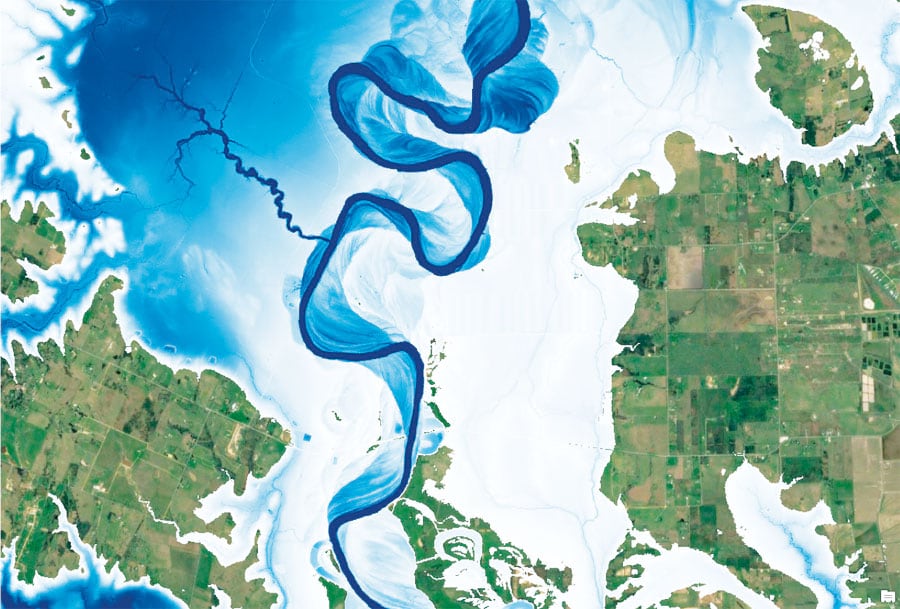On August 22, 2017, weather forecasting centers predicted that a tropical storm or hurricane would make landfall in or near Texas. Three days later, Hurricane Harvey struck and produced record rainfall—the most of any three-to-five-day storm in the history of the United States.
The University of Texas (UT) was ready for this. In 2016, the Texas Division of Emergency Management (TDEM) and the Federal Emergency Management Agency (FEMA) had approved a research project with UT called the Texas Flood Response Project, which Esri was involved in.
“The project had one overarching objective: How do you go from a radar rain map to a flooding inundation map showing impacts on the ground?” explained Harry Evans, the former chief of staff of the Austin Fire Department and a research fellow at UT Austin who now serves as a liaison between the academic and first responder communities. “Because of the work done with TDEM on this project, we were asked by the TDEM leadership to provide any assistance possible as Tropical Storm Harvey was forming in the Gulf of Mexico.”
That same day, TDEM activated the State Operations Center to serve as the emergency operations center for Texas’s statewide, regional, and local response and recovery efforts during the impending natural disaster. The director of TDEM, Chief Nim Kidd, invited UT to help TDEM’s Critical Information Systems (CIS) develop flood inundation maps. Bringing together a group of scientific researchers, GIS professionals from state and federal agencies, and a crew from Esri, UT’s group was dubbed the Hydrologic Long-Range Prediction Unit. The team’s objective was to coordinate hydrology and river hydraulic information each day from a range of agencies, including the National Weather Service, the West Gulf River Forecast Center, the United States Geological Survey (USGS), the US Army Corps of Engineers, FEMA, Texas river authorities, the Texas Department of Transportation, and more.
“This was done to provide situational awareness for county judges and emergency management coordinators in the dozens of affected communities,” said Evans. “We were also asked to provide daily flood inundation maps for ESF 9 (search and rescue) and others as necessary.”

Over the next few days, the team provided daily analyses of the water flow levels of 10 sentinel river sites that empty into Texas’s Gulf Coast. The monitoring points included the Nueces River at the city of Three Rivers, the San Antonio River at Goliad, the Guadalupe River at Victoria, the Navidad (Lavaca) River near Edna, and the Colorado River near Bay City, along with several others.
In collaboration with the National Weather Service and the West Gulf River Forecast Center, the US Army Corps of Engineers was able to use this information to generate inundation forecasts for the main stems of these major rivers. But this did not take into account all the areas between the main stem rivers and their tributaries. In these places, emergency managers were having to make decisions with little to no data from TDEM. This is where the National Water Model came into play.
Even though the forecasts for these areas were approximate, they at least gave emergency managers something to work with. Knowing if, or when, roadways would be flooded greatly aided agencies in making evacuation plans and ensuring that rescue resources could be moved in to affected areas. The National Water Model also helped the Hydrologic Long-Range Prediction Unit identify high ground where emergency responders could stage rescue resources or care for and shelter evacuees.
When Hurricane Harvey made landfall along the central coast of Texas on August 25, the National Water Center, the US Army Corps of Engineers, USGS, the West Gulf River Forecast Center, and FEMA were all already collaborating to create real-time maximum-predicted-inundation maps.
“All these agencies are amazingly skilled in their areas; however, it was astounding what the group was able to develop when it worked together,” said Evans. “For instance, the US Army Corps of Engineers and the West Gulf River Forecast Center were rock solid on the main stem rivers, but there was flooding on thousands of square miles beyond them. This is where the National Water Center, using the National Water Model, filled in the gaps on areas that had no authoritative forecasts. This level of collaboration is the future.”
Evans thinks the most impressive part of this project took form even before Harvey hit.
“Probably the most remarkable observations I had prior to landfall were the rainfall predictions coming from the various forecasts,” he recalled. “The inches of precipitation on some of the forecasts were unbelievable—40 to 50 inches, and more! So we looked at the prototype Texas Dashboard Impact Calculator we developed with Esri for TDEM and got a rough idea of the number of address points that would be inundated, as well as where they were located in the Houston and southeast Texas area, about 165 miles northeast of where the hurricane made landfall. We were able to assess the inland flood impact of the hurricane several hours before it reached the Texas coast.”
It is Evans’s sincere belief that the impact calculator, informed by the National Water Model and using any available stream gages and an ensemble of forecasts, can—and will—provide emergency managers with advanced warning of how bad flooding will be prior to a hurricane making landfall.
With his more than 30 years of experience working in emergency response and dealing with large-scale disasters, Evans understands the pressures emergency managers face to make quick decisions to safeguard lives.
“I’ve been that guy,” he said. “Many times, I had no real-time data and made decisions on past history, experience, and intuition. But having worked with the National Water Center, the West Gulf River Forecast Center, the US Army Corps of Engineers, USGS, TDEM, and Esri over the last two years, I couldn’t be more optimistic about the future of flood forecasts and predictions. Clearly, when faced with an epic disaster on the scale of Harvey, we are much more powerful and responsive when we all link arms and pull together.”

